How Roof Contractors Ensure Proper Installation for Maximum Durability
Just How Weather Can Influence Your Roofing Long Life
Your roofing faces consistent challenges from the climate, and it's important to understand exactly how these conditions can reduce its lifespan. UV rays can deteriorate materials, while hefty rain might lead to leakages. Snow and ice put included anxiety on the structure, and temperature level adjustments develop vulnerabilities. Each component plays a function in your roof's durability, however just how can you successfully prepare for these hazards? The answers may surprise you.
The Effects of UV Rays on Roof Products
When your roofing is exposed to sunshine, those dangerous rays can cause substantial damages over time. This deterioration deteriorates your roofing system and makes it less effective at shielding your home.
Regular examinations likewise aid catch very early signs of damages, allowing you to resolve problems prior to they intensify. By remaining proactive concerning UV exposure, you'll prolong the life of your roof and improve your home's total sturdiness.
How Extreme Rainfall Can Cause Roof Damages
While UV rays can deteriorate your roof, extreme rains positions one more significant danger to its honesty. When heavy rains take place, water can merge on your roofing system, causing potential leaks and structural damages over time. If your roof products aren't designed to manage prolonged direct exposure to moisture, they can wear away faster than anticipated.
Clogged up seamless gutters can aggravate these concerns, creating water to overflow and seep into your home. You may notice discolorations on your walls or ceilings, indicating that water is locating its way inside. Furthermore, standing water can promote mold and mildew growth, which not only damages your roof but can likewise impact your interior air high quality.
To secure your roofing, confirm your drain systems are clear and working appropriately. Routine assessments can assist you identify vulnerable points before they transform right into expensive repair services, maintaining your roofing healthy even throughout hefty rainfall.
The Impact of Snow and Ice Buildup
When snow and ice load up on your roofing, you may not realize the stress it places on the framework. That added weight can lead to serious concerns like roof covering drooping and even collapse. Plus, ice dam development can trap water, triggering leaks and more damage to your home.
Snow Tons Anxiety
As wintertime coverings your home in snow, the weight of collected ice and snow can put substantial anxiety on your roofing system. When snow accumulates, it can go beyond the load-bearing ability of your roof materials, bring about possible sagging or even collapse. You might not realize just how swiftly snow can collect, particularly during hefty storms, so it's crucial to watch on the weight your roof covering is supporting. On a regular basis getting rid of snow can assist alleviate this stress, reducing the danger of lasting damage. Additionally, understanding your roofing's structure and its snow lots score can notify you concerning when to act. Remember, avoidance is crucial to preserving your roofing system's stability and longevity throughout the cold weather.
Ice Dam Formation
Ice dam development can end up being a considerable issue throughout winter season, especially when snow gathers on your roofing and temperatures fluctuate. When warmth leaves from your home, it melts the snow on your roofing, causing water to move down. You ought to additionally routinely remove snow accumulation from your roofing.
Temperature Changes and Their Duty in Roof Damage
Temperature fluctuations can seriously influence your roof covering's life-span. As materials expand and contract with warm and cold, they come to be much more susceptible to fractures and damage. Furthermore, freeze-thaw cycles can exacerbate these issues, bring about additional wear and tear with time.
Thermal Expansion Impacts
When temperature levels vary, your roofing can go through substantial thermal expansion and contraction, which might lead to material anxiety and deterioration gradually. As the sunlight warms your roofing system throughout the day, products increase; when temperatures drop during the night, they get. This continuous cycle can produce weak places, particularly at seams and joints. You could notice fractures, bending, or loosened tiles therefore. If left unattended, these problems can result in leaks and pricey repairs. To minimize damages, take into consideration using roof materials developed to stand up to these temperature level adjustments. Normal inspections can also assist you capture very early indicators of wear, guaranteeing your roof remains effective and resilient in securing your home.
Freeze-Thaw Cycles
As winter collections in, the freeze-thaw cycles can damage your roof. Moisture from rainfall or snow permeates into splits and holes when temperature levels dip. As it ices up, it broadens, putting enormous stress on your roof materials. This cycle repeats as temperatures increase and fall, gradually creating damage. You may discover shingles fracturing, crinkling, and even damaging apart with time.
Ignoring these issues can cause even more significant issues, consisting of leaks and structural damage. To secure your roofing system, it's important to evaluate it on a regular basis, especially after extreme weather condition. Resolving minor issues quickly can aid expand the life of your roof, ensuring it stands up to the rough results of freeze-thaw cycles throughout winter.
Humidity Levels and Their Effect on Roofing System Stability
While many individuals concentrate on temperature level fluctuations, humidity levels play a vital duty in establishing the integrity of your roof. High humidity can create a damp setting that encourages mold and mildew, algae, and mold growth, every one of which can damage roof products with time. If your roofing system's air flow isn't sufficient, moisture can obtain trapped, Continued causing timber rot and various other architectural issues.
Conversely, low humidity can bring about dry conditions, creating materials like shingles to become breakable and crack. This brittleness can make them more prone to harm from various other climate aspects.
To maintain your roof's honesty, it is essential to keep track of humidity degrees and ensure proper air flow. Regular inspections and upkeep can assist recognize prospective issues prior to they end up being significant issues. Keeping your roof covering in great condition suggests being positive about moisture effects, eventually prolonging its life-span and protecting your home.
Wind Damages: A Silent Hazard to Your Roofing System
Moisture isn't the only weather condition factor to consider; wind damages can quietly intimidate your roofing system's honesty. Solid winds can lift tiles, loosen up flashing, and even detach entire sections of your roof covering. You might not observe these issues quickly, however with time, they can result in substantial leaks and Visit Your URL structural damages.
If you reside in a location prone to high winds, it is necessary to watch on your roofing system after storms. Check for any kind of missing out on or harmed shingles and check the edges where the roof covering meets other surface areas. Roof Replacement Novi. Focus on any debris that may have collected, as this can catch dampness and get worse damages
Ignoring these indicators could save you time currently, yet it might cost you more in the future. An aggressive approach to wind damage can help guarantee your roof remains safe and secure and solid, extending its life expectancy and securing your home.
Preparing Your Roofing for Extreme Weather Condition Events
When preparing your roof for severe climate events, it's important to evaluate its current problem and make essential upgrades. Begin by examining for missing or harmed roof shingles, as these can result in leakages throughout heavy rainfall or snow. Change any compromised products to guarantee a strong structure.
Next, examine the blinking around smokeshafts, skylights, and vents. Properly secured flashing prevents water from permeating in, which can trigger considerable damage.
Consider reinforcing your roofing's structure, especially if your location is susceptible to high winds or heavy snowfall. Mounting impact-resistant tiles can include an additional layer of protection.
Ultimately, clear rain gutters and downspouts to advertise appropriate drain. Clogged seamless gutters can cause ice dams or roofing system leakages. By taking these aggressive steps, you'll aid prolong your roof's life expectancy and decrease prospective damages during extreme climate events.

Often Asked Concerns
How Typically Should I Examine My Roofing System for Weather Damages?

Can I Repair Roof Damage Triggered by Climate Myself?
Yes, you can repair roof covering damage brought on by climate on your own if you have the right devices and skills. Just make sure you focus on safety, analyze the damages thoroughly, and comply with proper repair work strategies to avoid future concerns.
What Roof Materials Are Finest for Extreme Weather Condition?
For extreme weather condition, think about metal, slate, or impact-resistant shingles. These materials withstand hefty winds, hail storm, and snow far better than others. You'll ensure your roofing lasts longer, safeguarding your home from severe elements effectively.
Just How Does Environment Modification Affect Roofing Longevity?
Environment modification speeds up wear on your roof, creating materials look at this website to deteriorate faster. Raised temperature levels and severe tornados can bring about more frequent repairs. You'll require to consider resistant choices to ensure your roof lasts much longer.
Should I Think About a Roof Service Warranty for Weather-Related Issues?
Yes, you must certainly take into consideration a roofing warranty for weather-related concerns. It secures you against unanticipated damage, guaranteeing your financial investment remains safe and secure. Plus, it gives peace of mind throughout unforeseeable climate condition.
How Too Much Rainfall Can Lead to Roof Covering Damage
When hefty rains take place, water can pool on your roof covering, leading to prospective leakages and structural damage over time.Moisture isn't the only weather aspect to contemplate; wind damage can calmly threaten your roofing's integrity. By taking these positive actions, you'll assist expand your roof's life expectancy and decrease prospective damages during extreme weather condition events.
Can I Fix Roof Damages Triggered by Weather Myself?